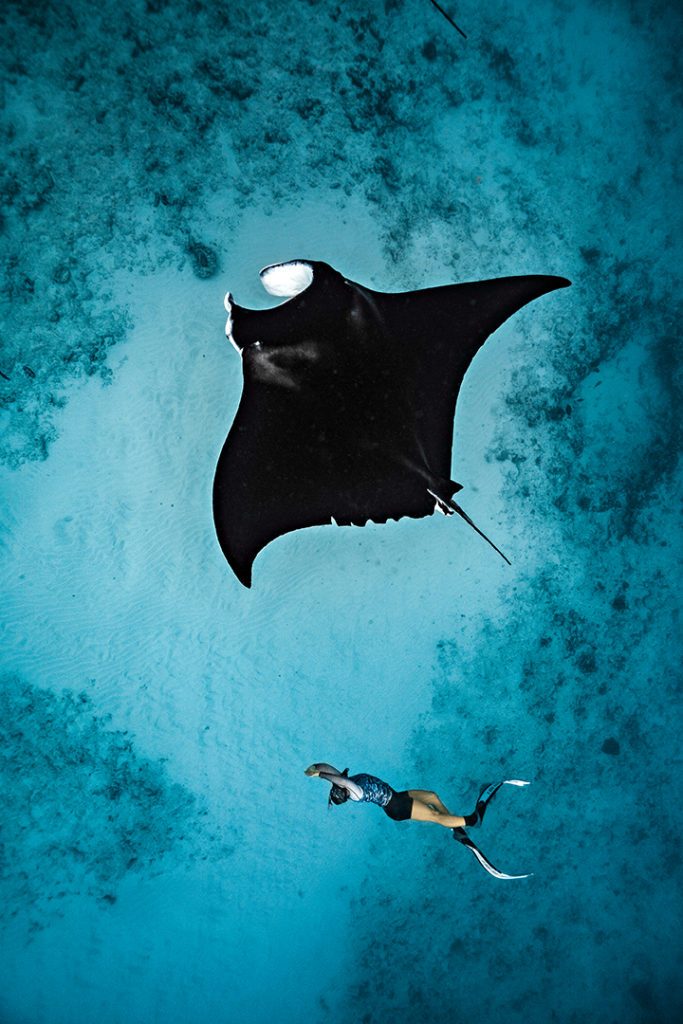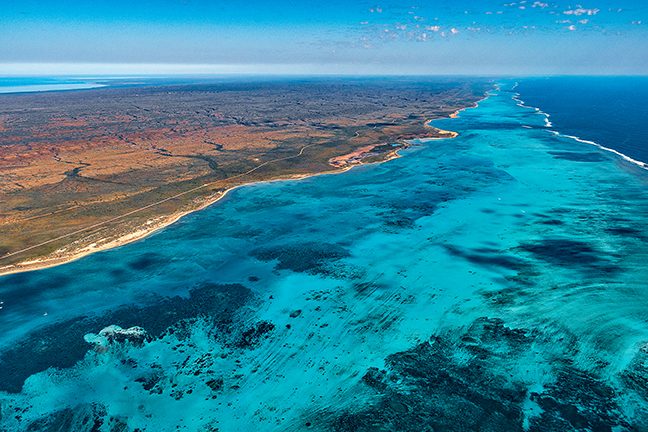One of Australia’s best-kept secrets
AN OTHERWORLDLY LANDSCAPE lies on the western coast of Australia, where the red outback meets the iridescent blue of the Indian Ocean. This magical place is the Ningaloo Reef, or Nyinggulu in the local Aboriginal language.
Ningaloo is Australia’s only fringing reef and the largest one in the world. Different from a barrier reef, a fringing reef is close to shore and easily accessible. In some areas the outer reef is as close as 437 yards (400 meters) from the shore. The Ningaloo Reef is about 186 miles (300 kilometers) long and runs from the Muiron Islands to Red Bluff on Western Australia’s Coral Coast.
The reef is a haven for ocean enthusiasts and divers in search of once-in-a-lifetime encounters with marine megafauna. One of the most famous visitors to the area is the whale shark. This bustling area is also home to humpback whales that come to rest while on their annual migration. A permanent population of reef mantas feeds along the coast, and a rare giant oceanic manta will occasionally visit. Any photographer, diver, or nature lover should add the Ningaloo Coast, a United Nations World Heritage Site, to their bucket list.
Where Red Meets Blue
Many people are familiar with Australia’s famous Great Barrier Reef, but the Ningaloo Reef is perhaps one of Australia’s best-kept secrets. It is one of the few places in the world where you can almost be guaranteed to swim with a whale shark in an ecofriendly way.
Ningaloo is a bit off the beaten track. I had admired it from afar long before I moved to the small, remote town of Exmouth. Years ago an old friend told me about this faraway place where you could swim with whale sharks. At that time I had never heard of the Ningaloo Reef. After doing some research, however, I discovered it was the perfect location for anyone who wanted to photograph large marine animals along a healthy coral reef and with the ease of swimming from the shore.


The Ningaloo Coast
Nyinggulu comes from the Aboriginal word for “deep water.” Ningaloo Reef sits closely to Australia’s continental shelf, where the ocean floor drops off to depths of more than 3,200 feet (1,000 meters). This unique deep-sea environment creates a wildlife corridor for many pelagic species that visit seasonally.
The reef itself hosts an array of marine life big and small, with more than 500 species of fish and 300 species of coral — from healthy coral reef systems to tiger sharks, sting rays, sea turtles, hammerhead sharks, leopard sharks, dugongs, orcas, dolphins, humpback whales, and even the occasional blue whale. The reef also supports some well-established and highly regulated ocean-based tourism activities that focus on swimming with megafauna. What you can see here and the ways in which you can explore it almost never ends.
An alien landscape greets you upon arrival to the Ningaloo Coast. The rugged, rocky ridges and canyons seem to glow red and orange, especially around sunset. The bright-blue water that meets the coast and the turquoise inner reef create a mesmerizing contrast of colors in a biological transition zone, where the temperate desert meets a tropical reef system. This rare mix of environments creates a diverse and interconnected ecosystem.
The Ningaloo Coast World Heritage Area covers 2,334 square miles (604,500 hectares) and stretches for more than 186 miles (300 kilometers). The marine habitats vary from deep ocean to continental slopes, islands, estuaries, mangroves, and cave systems. The Cape Range National Park that runs parallel to the western coast has marine fossils and limestone cave systems that host rare subterranean fauna. Millions of years ago the range would have been below sea level. A short hike into some of the gorges will reveal rocks embedded with shells and marine fossils. If you know where to look, you can sometimes find fossilized megalodon teeth — one of Ningaloo’s many hidden secrets.
Exmouth
Exmouth, on the northern tip of Ningaloo Reef, is 746 miles (1,200 kilometers) north of Perth. The town is a tourism hotspot for snorkeling, surfing, diving, and fishing tours as well as aerial flights, hiking, kayaking, four-wheel driving, and camping.




Whale Sharks
Whale sharks are the area’s main attraction. Locals have been swimming with them here since the 1980s, and it didn’t take long for operators to start running tours. Since then, the whale shark industry in Ningaloo has become one of the most ecofriendly in the world. Strict regulations are in place to minimize disturbance to the animals during interactions. Rules include limiting group sizes to 10 swimmers, with trained guides accompanying each group, and maintaining a 10-foot (3-meter) minimum distance between swimmers and the animals.
Some tour operators elsewhere in the world often feed and bait the whale sharks, but here the operators use spotter planes to survey the reef and guide the boats to the animals. The arrival of the whale sharks each season kicks off after the coral-spawning events around the full moons in March and April. As many as 600 whale sharks may visit the coast during the peak season, and 85 percent of them are juvenile males with an average size of 20 feet (6 meters).
The first time I swam with whale sharks, I could not stop smiling for hours afterward. It’s amazing how small you feel when swimming near the ocean’s largest living fish. Although I now do it often for my job, the thrill never wears off. Be prepared for some awe-inspiring emotions, whether it is your first time or 100th time to swim with the whale sharks.


Other Mega Marine Life
From June to October, humpback whales pass by Ningaloo Reef on their annual migration from their summer feeding grounds in Antarctica to their birthing grounds in Camden Sound just north of Broome, Australia. This journey is one of the longest migrations of any mammal, with a round trip of about 8,078 miles (13,000 kilometers).
The warm, protected waters near Broome provide a safe haven where mothers can give birth, rest, and feed their young and where males will court and mate with ready females before returning south for the summer. On their way back south, many mothers with calves will also stop by Ningaloo in the Gulf of Exmouth to rest on their journey. Some whales stop there and don’t make the journey to Broome.
Spotter pilots working in the area have witnessed several births, and seeing calves early in the season is fairly common on the Ningaloo Coast. More than 40,000 humpbacks pass by the coast each year. Some operators have a license to conduct in-water humpback whale interactions, which run from late June until October.
My first humpback whale swim was with a mother and calf. As the whales approached, we listened to the radio that communicates with the spotter pilot, who told us which way to swim so we would be in the right place for when the whales pass by. The huge mother took a loud breath at the surface about 55 yards (50 meters) away. The air she expelled from her lungs was roughly the volume of a small car.
We waited patiently as they approached; when they were 33 yards (30 meters) away, the pilot told us to put our faces in the water. First, I saw the white of the whales’ bellies glowing in the blue water and then their whole bodies as they fully emerged from the blue. The two whales cruised by us, and the calf did a cheeky little turn sideways, showing us his belly, so he could look directly at us with both eyes. They eventually moved away and resumed their journey south. When the boat picked us up, everyone in our group cheered with pure joy from the simultaneous adrenaline rush and extreme sense of calm experienced in the moment.
Swimming with manta rays is a different experience. They inhabit the coast all year, and the best chance to see one is by driving to Coral Bay, an hour and a half south of Exmouth, where operators run manta-specific tours daily. The best time to see manta rays is around the full moon, when they come to shallower areas of the reef to clean, feed, and sometimes find a mate.
Murion Islands and Exmouth Navy Pier
Exmouth has a world-famous pier dive that has been rated as one of the top shore dives in the world. The 328-yard (300-meter) pier sits on an active navy base north of town and hosts a dense array of life — at some points you can barely see your dive buddy through the abundance of fish. Here you can encounter dense schools of jacks, huge friendly groupers, colorful reef fish, wobbegongs, sea snakes, seasonal visiting gray nurse sharks, vibrant sea fans, soft corals, and all sorts of macro critters and nudibranchs.
The Murion Islands are another great option for scuba diving. Located to the north of North West Cape, the two islands provide an array of marine life different from on the western side. The reef around the islands is full of soft corals, colorful sea fans, and an abundance of turtles and reef sharks. It is a great location for macro lovers, who can find many species of nudibranchs, frogfish, lionfish, pipefish, and crustaceans. AD
© Alert Diver — Q2 2023
How to Dive It
Getting there: From Perth, fly to Learmonth Airport, which is a 30-minute bus ride to Exmouth. This is a remote part of the Australian outback without taxis or public transportation, so renting a car is beneficial. Accommodations are often in high demand in the small and isolated towns of Exmouth and Coral Bay, so secure lodging in advance. Access to Cape Range National Park’s beaches and snorkeling areas requires a national park pass. If you are traveling from outside Australia, information about entry requirements is at abf.gov.au/entering-and-leaving-australia/crossing-the-border.
The best time for swimming with whale sharks is from March until July, but April and May are best in terms of the number of whale sharks in the area, water visibility, and weather conditions. Several operators based in Exmouth and Coral Bay run whale shark tours daily during the season; spaces on each tour are limited, so book tours well in advance.

Conditions: The Ningaloo coast is exposed to wind and swell during the winter months, and summer is the cyclone season for the northwest of the state. Many dive and megafauna tours are conducted in the open ocean, so weather and sea states can greatly affect their operations. In the cooler months, air temperatures are between 46°F (8°C) at night and 77°F (25°C) during the day. In the hottest months, temperatures will vary between 68°F (20°C) and 113°F (45°C).
Water temperatures also vary depending on the wind, tides, and time of year. In the summer, from December to February, water temperatures range between 80°F (27°C) to 86°F (30°C). From March to May, temperatures can be 75°F (24°C) to 80°F (27°C). Winter water temperatures reach as low as 64°F (18°C) to 75°F (24°C). Spring can warm to 71°F (22°C) to 79°F (26°C).
Dive safety: The western coast of Australia has seasonal stingers and jellyfish. Be aware of the Irukandji, a type of box jellyfish whose stings can be very painful and usually require hospitalization. A full wetsuit or stinger suit is recommended, especially during the colder months. Stingers are more frequent on the outer reef.
Currents vary with tidal movements, and the dive and snorkel operators plan their dive times and sites according to conditions. Some sites are drift dives, so experience with currents will enhance your safety. When snorkeling from beaches in the national park, be aware that some sections may have fast-moving or rip currents. These areas are usually marked, but use caution, and don’t snorkel alone.